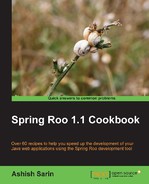The controller all command let's you create controllers for all JPA entities for which a corresponding controller doesn't exist. If you want to control the web request path to which the controller is mapped or the operations supported by the controller, then you should use the controller scaffold command.
Delete the contents of the ch04-recipe sub-directory inside the C:
oo-cookbook directory.
Copy the ch04_web-app.roo script into the ch04-recipe directory.
Execute the ch04_web-app.roo script that creates the flight-app Roo project, sets up Hibernate as the persistence provider, configures MySQL as the database for the application, creates Flight and the FlightDescription JPA entities, and defines a many-to-one relationship between the Flight and FlightDescription entities. If you are using a different database than MySQL or your connection settings are different than what is specified in the script, then modify the script accordingly.
Start the Roo shell from the C:
oo-cookbookch04-recipe directory.
The following steps show how
to use the controller scaffold command to create controllers for JPA entities:
- Execute the
controllerscaffoldcommand to createFlightController, as shown here:..roo> controller scaffold --class ~.web.FlightController --entity ~.domain.Flight --path /myflightpath --disallowedOperations update,delete
- Execute the
perform eclipsecommand to update the classpath settings, and import the project in your Eclipse IDE.
The following table describes the purpose of each of the arguments passed to the controller scaffold command:
The following code from the FlightController.java file shows the FlightController created by the controller scaffold command:
@RooWebScaffold(path = "myflightpath", formBackingObject = Flight.class, update = false, delete = false) @RequestMapping("/myflightpath") @Controller public class FlightController { }
As the given code shows, the value of the path attribute of the @RooWebScaffold annotation and the @RequestMapping annotations are derived from the value of the path argument of the controller scaffold command. The value of the disallowedOperations argument of the controller scaffold command is used in the @RooWebScaffold annotation to specify the operations that are not supported by the generated controller.
The following table describes the elements of the @RooWebScaffold annotation:
The following table describes methods that form part of the *_Roo_Controller.aj ITD, assuming that all controller operations were generated:
As shown in this recipe, the controller scaffold command provides options to help create a customized controller. Even if you have created controllers using the controller all command, you can still customize the controller by setting the attributes of the @RooWebScaffold annotation.
Let's now see how you can override the auto-generated methods in the *_Roo_Controller.aj file:
In some scenarios, you may want to override the auto-generated methods of the *_Roo_Controller.aj file to provide custom implementation. To override a method defined in ITD, all you need to do is to define a method with the same or different arguments and return types, but with the same name, in your controller Java file.
Let's say that in our flight-app web application we need to address the following requirements:
- Currently, when a
Flightentity instance is updated theFlightControllershows the updated entity instance in a read-only view. This default functionality needs to be changed such that after update, the controller shows the list ofFlightinstances. - To address this requirement, we need to override the default behavior of the
updatemethod defined in theFlightController_Roo_Controller.ajITD. To override the default behavior of theupdatemethod, all you need to do is to define anupdatemethod (with the same or different arguments and return types) in theFlightController.javafile, as shown here:@RequestMapping(method = RequestMethod.PUT) public String update(@Valid Flight flight, ..) { .... return "redirect: /myflightpath/list"; }In the given code, the
updatemethod redirects the user tomyflightpath/list(instead of/myflightpath/{flightId}) after persisting changes to theFlightentity.
